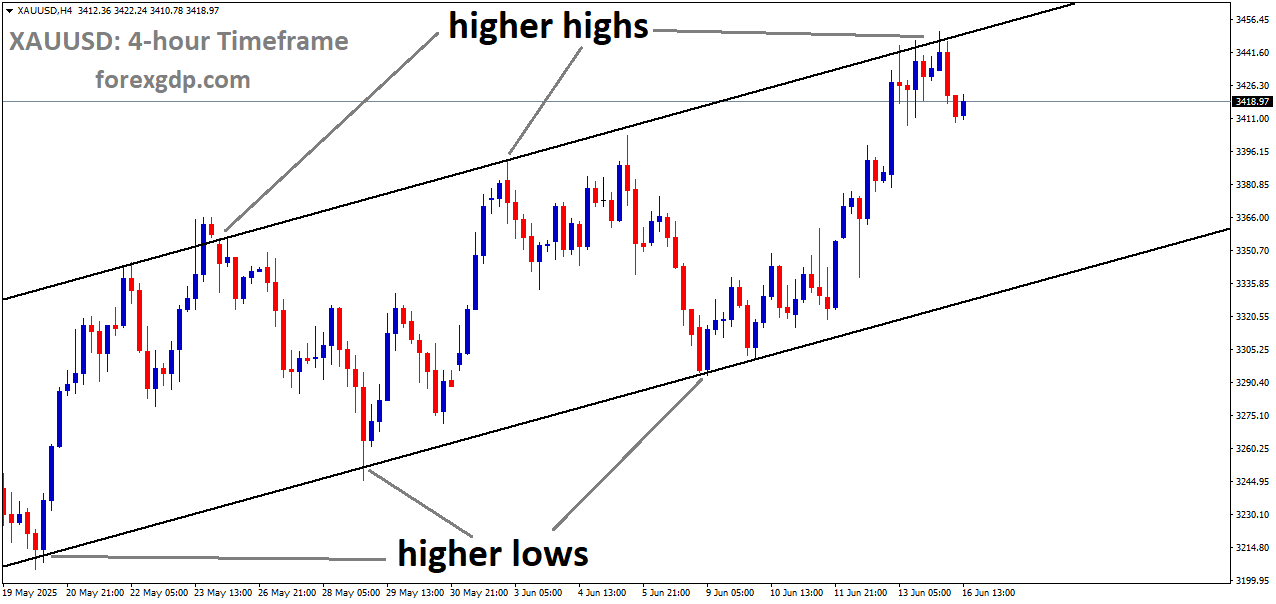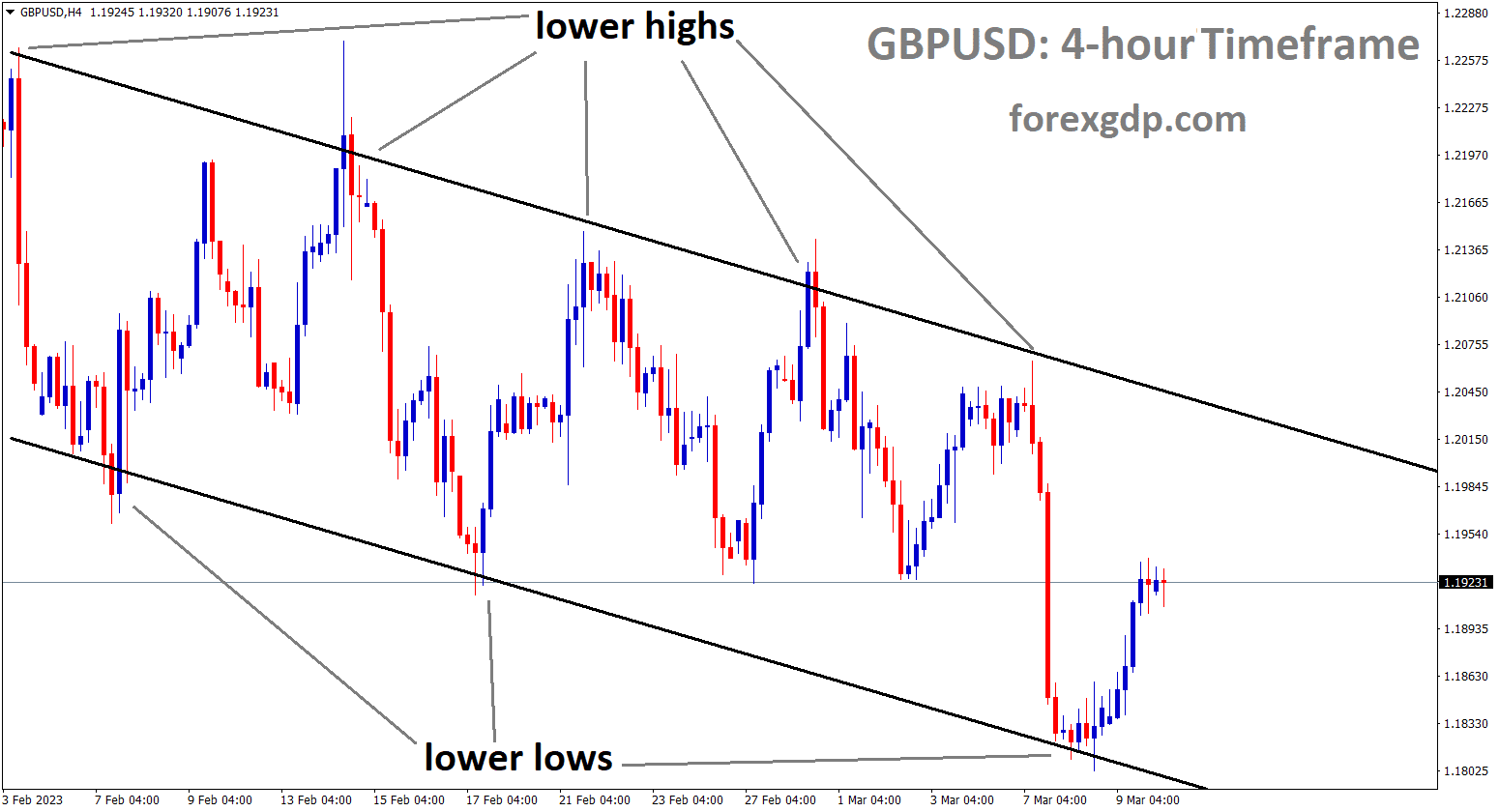XAUUSD – Gold Drops Below $2,500, All Eyes on Upcoming US Inflation Figures
Gold Prices Drop Amid Speculation Around Federal Rate Cuts
Gold has always been an intriguing asset to follow, especially when global economic developments come into play. Over the past few days, gold prices have faced significant pressure, particularly after failing to break a key resistance point. With speculation about interest rate cuts intensifying, there’s much more to this story than just market fluctuations. Let’s dive into what’s happening with gold, why it’s tumbling, and what’s affecting its prices in the market.
Gold’s Struggle and the Interest Rate Speculation
Gold took a noticeable dip, unable to maintain its momentum. It retreated from its high of $2,531, closing at $2,493. This drop came as anticipation over potential Federal Reserve rate cuts grew stronger, especially after the release of the US Nonfarm Payrolls (NFP) data. While these fluctuations in gold’s price can seem complex, they stem from various economic factors, particularly the uncertainty surrounding Federal Reserve interest rate decisions.
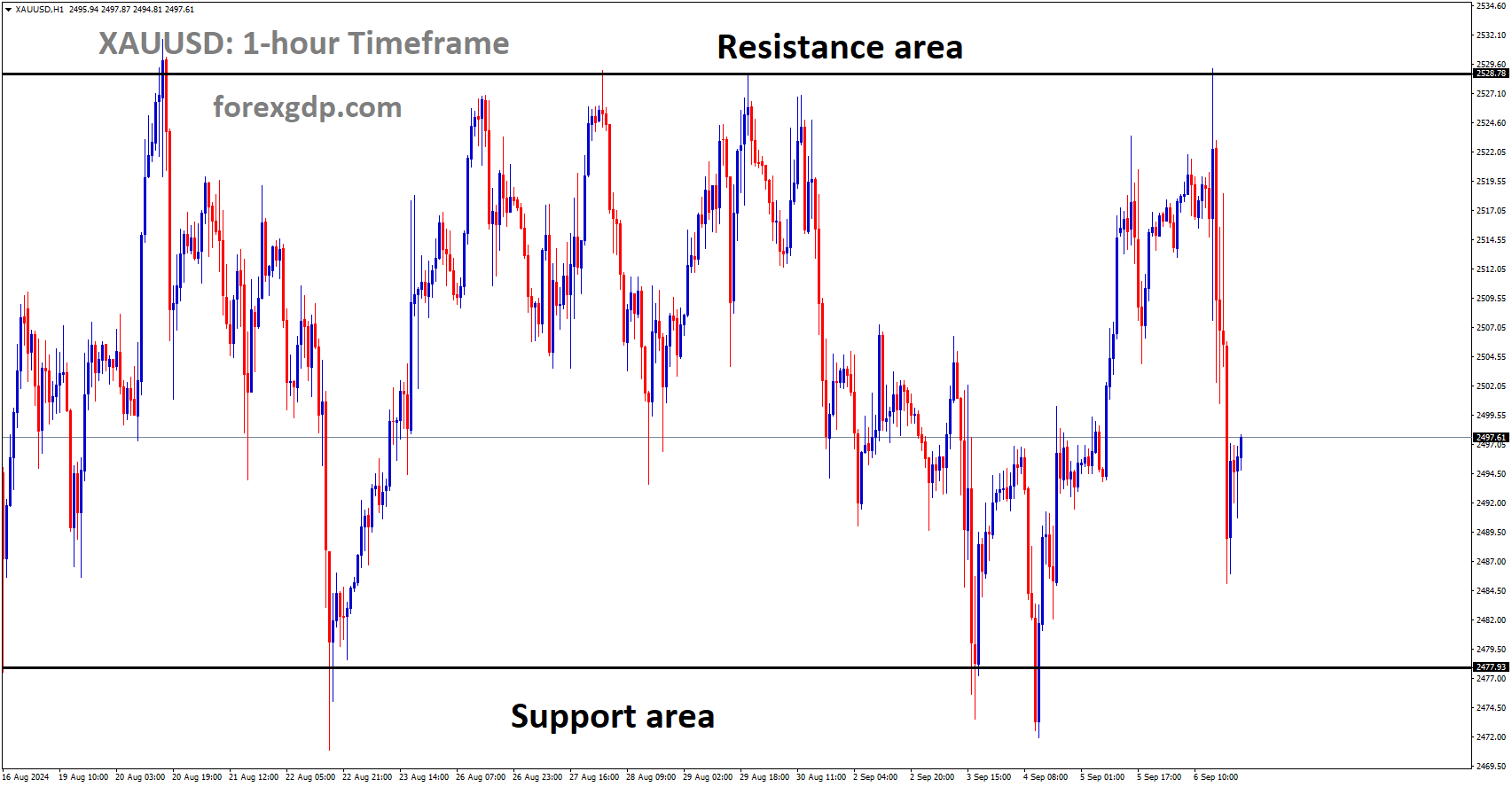
XAUUSD is moving in a box pattern, and the market has fallen from the resistance area of the pattern
The Role of US Nonfarm Payrolls (NFP)
One of the critical pieces of information that influenced gold’s recent decline was the US Nonfarm Payrolls report. The NFP is a significant economic indicator as it gives a snapshot of the health of the labor market. In August, the NFP figures missed expectations, causing waves of uncertainty in the financial markets. But there’s more to it than just a miss.
Let’s break it down:
- Missed Estimates but Improved Overall: Although the NFP missed the expected figure, there was still some positive news. The numbers for August showed improvement over July’s revised data, which pointed to a slightly better employment situation.
- Rising Hourly Wages: Another critical factor was the increase in Average Hourly Earnings. This uptick can be seen as a sign of inflationary pressure, which can influence the Fed’s decision-making process on whether to cut interest rates or not.
- Unemployment Rate: The unemployment rate saw a slight dip, which would typically be positive for the economy but added to the uncertainty about the Fed’s future rate decisions.
This mixed bag of data left market participants scratching their heads and wondering whether the Federal Reserve would go for a 25 or 50 basis points (bps) rate cut.
Federal Reserve Rate Cut Speculation: What’s the Buzz About?
The Federal Reserve’s decisions on interest rates have a significant impact on global financial markets, and gold is no exception. Speculation around these decisions intensified recently, as traders and investors closely monitored comments from key Fed officials and analyzed the latest economic data.
At the heart of this speculation was the idea that the Fed could cut interest rates either by 25 bps or 50 bps at its upcoming September meeting. Let’s take a look at the factors influencing this debate:
Comments from Federal Reserve Officials
Fed policymakers have been making headlines with their comments about future rate cuts. Notably, New York Fed President John Williams emphasized that reducing rates sooner rather than later would help maintain balance in the labor market. Similarly, Fed Governor Christopher Waller echoed these sentiments, even suggesting that he was open to easing policies, regardless of the size of the cut.
Adding to this dovish tone, Chicago Fed President Austan Goolsbee remarked that there was an “overwhelming consensus” among policymakers to reduce borrowing costs. These comments only fueled further speculation about the size and timing of any future rate cuts.
Market Reaction and FedWatch Tool
One way to gauge market sentiment is through tools like the CME FedWatch Tool, which measures the likelihood of different rate cuts based on market data. At one point, the probability of a 50 bps cut shot up to 70%, but as the dust settled, it became clear that a 25 bps cut was more likely. By the end of the trading day, the market priced in a 73% chance of a 25 bps cut, with the odds of a 50 bps cut dropping to 27%.
This constant back-and-forth about the size of the rate cut left gold prices struggling, as investors tried to anticipate the Fed’s next move.
Impact of the US Dollar and Treasury Yields on Gold
Another crucial factor that has been weighing on gold prices is the performance of the US Dollar and Treasury yields. Typically, when Treasury yields fall, gold tends to rise. However, this hasn’t been the case in recent days.
Despite falling Treasury yields, the US Dollar Index (DXY) saw a recovery, climbing back above the 101.00 level. The dollar’s strength made gold, which is priced in dollars, more expensive for foreign investors, thereby reducing demand for the precious metal. The DXY’s rebound was a key factor contributing to gold’s slide.
Geopolitical Factors: Blinken’s Comments on Gaza
While economic factors have been dominating the headlines, geopolitical developments have also played a role in shaping market sentiment. US Secretary of State Antony Blinken recently commented on the ongoing ceasefire negotiations in Gaza. According to him, 90% of the agreement had been finalized, but critical issues remained unresolved. This geopolitical uncertainty can often lead to shifts in investor behavior, particularly when it comes to safe-haven assets like gold.
Although Blinken’s comments didn’t have a direct impact on gold prices, they added to the broader sense of uncertainty in global markets. Investors often turn to gold in times of geopolitical tension, but in this case, the stronger US dollar and rising interest rate speculation outweighed any potential safe-haven demand.
Daily Market Movers: What’s Behind Gold’s Decline?

Now, let’s summarize some of the major market movers that contributed to the recent decline in gold prices.
- Mixed US Jobs Report: The August NFP report was a significant factor, with the headline figure missing expectations but still showing improvements over the previous month.
- Hourly Earnings Increase: Rising hourly earnings contributed to inflationary pressures, adding complexity to the Fed’s decision-making process.
- US Dollar Strength: A recovering US dollar put downward pressure on gold prices, as it made gold less attractive to foreign investors.
- Fed Rate Cut Speculation: Speculation around the size of the Fed’s next rate cut kept investors on edge, with opinions fluctuating between a 25 bps and 50 bps cut.
Wrapping It All Up
Gold’s recent decline can be attributed to a complex mix of factors, including economic data, Federal Reserve interest rate speculation, and the performance of the US dollar. While the August Nonfarm Payrolls report added uncertainty to the outlook for interest rate cuts, comments from Fed officials seemed to lean toward easing monetary policy in the near future.

XAUUSD is moving in an Ascending channel, and the market has reached the higher high area of the channel
At the same time, the US dollar’s recovery and rising hourly earnings further complicated the picture, putting additional pressure on gold prices. As always, gold remains a volatile and unpredictable asset, and its performance in the coming days will likely depend on further developments in US economic data and the Federal Reserve’s next move.
So, what does this all mean for you? If you’re watching gold prices, it’s essential to keep an eye on the broader economic picture. Whether you’re investing, trading, or just curious, understanding these dynamics will help you make sense of gold’s ups and downs.
EURUSD – Euro Slips as EUR/USD Drops Under 1.1100 Following Weak US Labor Data
EUR/USD Dips Below 1.1100 as US Dollar Surges Despite Labor Market Concerns
The EUR/USD exchange rate took a notable dip, falling below 1.1100 as the US Dollar rebounded strongly. This surprising bounce in the dollar happened even in the face of signs indicating a slowdown in US labor demand. The market is abuzz with speculation about the Federal Reserve’s next move regarding interest rate cuts, and traders are divided on what to expect. At the same time, all eyes are on the European Central Bank (ECB), with expectations of further interest rate cuts as the year progresses.

Let’s dive into the details of why the EUR/USD pair saw such movement and what factors are currently influencing both currencies.
EUR/USD Sees a Sharp Drop Below 1.1100
At the start of the week, the EUR/USD pair was holding its ground, even managing to hit a high of 1.1150 during Friday’s North American session. However, those gains quickly vanished as the US Dollar began to recover, causing the pair to slide back below the 1.1100 mark. The USD’s recovery took many by surprise, especially given the recent negative data pointing toward a weakening US labor market.
So, what caused the US Dollar to surge unexpectedly?
One key factor was the US Dollar Index (DXY), which tracks the dollar’s value against six other major currencies. After posting losses earlier in the day, the DXY reversed course and jumped to 101.40, giving the USD a much-needed boost. This jump came despite some disappointing labor data from the US, which seemed to initially weaken the dollar’s appeal.
US Labor Market Data: A Mixed Bag
The US labor market has been sending mixed signals recently. August’s Nonfarm Payrolls (NFP) report revealed that 142,000 jobs were added, which was lower than the 160,000 expected. However, the figure was still an improvement over July’s revised number of 89,000 (down from the previous estimate of 114,000). On the bright side, the unemployment rate dropped from 4.3% to 4.2%, which aligned with market expectations.

EURUSD is moving in an Ascending channel, and the market has reached the higher low area of the channel
These labor market figures were a clear indicator of some slowdown, yet they weren’t entirely gloomy. The US economy was still creating jobs, just not at the pace many had hoped for. Interestingly, the softer-than-expected data didn’t immediately cause the USD to collapse, as many might have expected. In fact, the dollar’s bounce showed that the currency still had some resilience left.
Other Data That Shook Up the Market
The NFP report wasn’t the only labor-related data release that week. Earlier, the Job Openings and Labor Turnover Survey (JOLTS) report for July, as well as the ADP private sector employment data for August, further fueled concerns about weakening labor demand. According to the JOLTS report, job openings fell to 7.67 million, their lowest level in over three years. Similarly, ADP reported only 99,000 new payrolls, the weakest number in recent memory.
Despite these signals of a weakening labor market, the dollar managed to remain strong, in part due to other economic reports, such as the ISM Services PMI, which came in better than anticipated. This helped provide a cushion for the USD, even though signs of labor demand weakening were becoming more apparent.
Will the Fed Cut Interest Rates? Traders Remain Divided
The softening labor data and broader economic concerns have led many to believe that the Federal Reserve may be on the brink of cutting interest rates, possibly even aggressively. There’s growing speculation that the Fed could lower rates by as much as 50 basis points (bps) in the near future, which would bring rates down to a range of 4.75% to 5.00%.

As of now, market sentiment is mixed. According to the CME FedWatch Tool, the chances of such a cut have jumped to 43%, up from 34% just a week prior. These figures show that traders are still unsure about how aggressive the Fed will be when it comes to reducing interest rates. The central bank has been hesitant to cut rates too quickly, but with growing signs of a slowdown, it may not have a choice.
Eurozone Faces Uncertainty Amid Expected ECB Rate Cuts
On the other side of the Atlantic, the Euro hasn’t had it easy either. While the Euro initially showed some strength against its major peers, it struggled to maintain momentum, especially as traders were left uncertain about the ECB’s next moves. The ECB has already started its rate-cutting cycle but took a brief pause in July after kicking things off in June.
The ECB is widely expected to cut rates further before the end of the year, with many traders betting on cuts in either the November or December meetings—or even both. Most economists agree that the ECB will continue easing policy as the Eurozone grapples with a fragile recovery.
Challenges Facing the Eurozone Economy
The Eurozone’s economic outlook has become more clouded, as its two largest economies, Germany and France, have shown signs of slowing down. In Germany, industrial production fell by a whopping 2.4% in July, far worse than the 0.3% drop expected by economists. Over in France, industrial output also took a hit, dipping by 0.5%. These figures highlight the ongoing struggles of the Eurozone as it deals with internal and external pressures, including a slowdown in China, which has been one of its key trading partners.
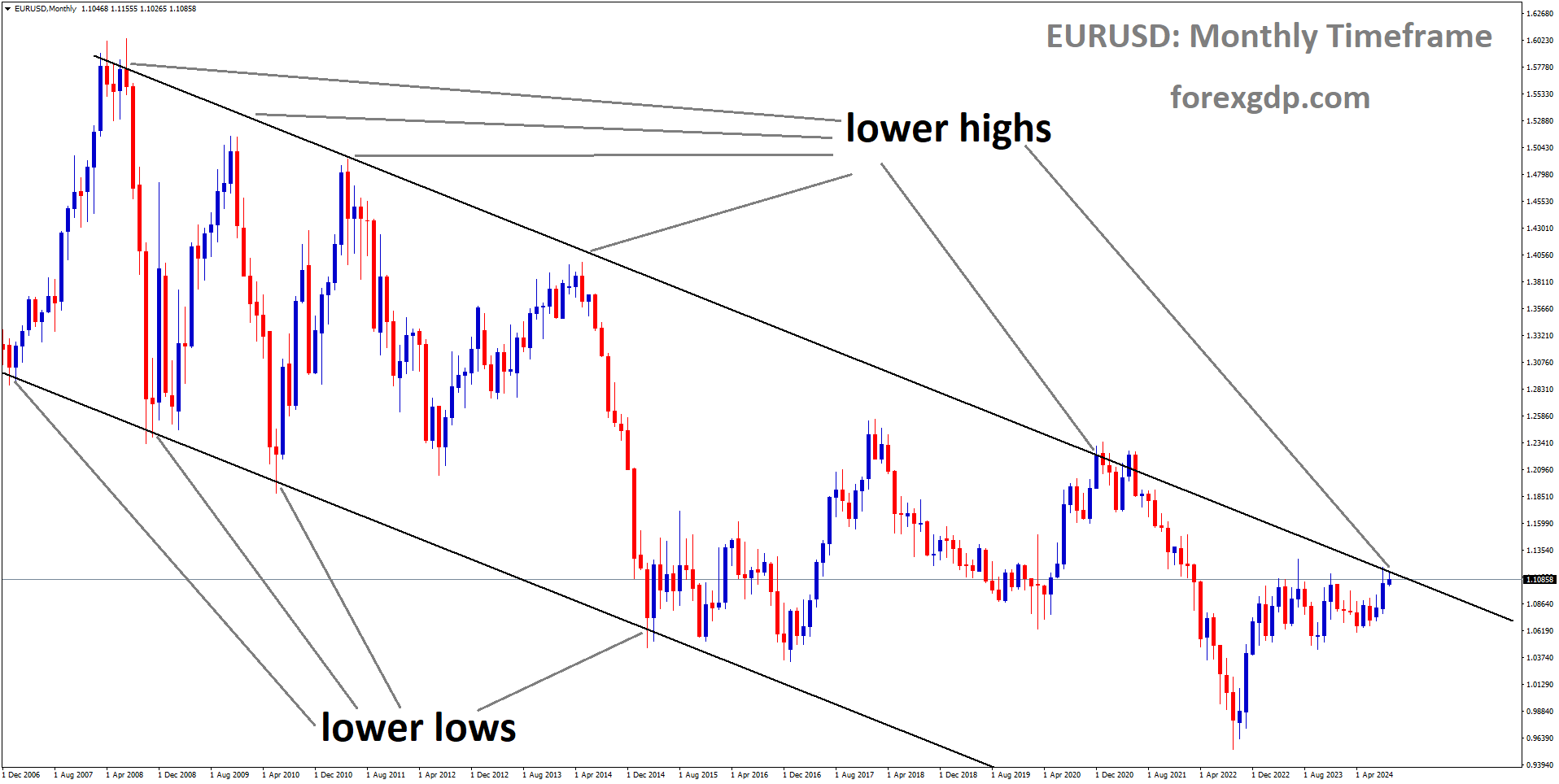
EURUSD is moving in a descending channel, and the market has reached the lower high area of the channel
Economists at Bank of America recently weighed in on the Eurozone’s situation, predicting that further rate cuts are likely in 2025 and 2026, with the deposit rate potentially falling back to 2% by the third quarter of 2025. They also cautioned that the recovery in the Eurozone could be slow and shallow, given the multiple economic headwinds facing the region.
Final Summary: What’s Next for EUR/USD?
The EUR/USD pair’s sharp drop below 1.1100 was driven by a combination of factors, including a stronger-than-expected rebound in the US Dollar, despite weak labor market data. Traders are now closely watching the Federal Reserve and the European Central Bank for any signals of future rate cuts. While the Fed is facing pressure to act amid signs of slowing labor demand, the ECB is also navigating a difficult economic environment in the Eurozone, with more rate cuts expected before the end of the year.
For now, both the Euro and the Dollar face uncertainty as the global economic landscape remains fragile. Traders will be keeping a close eye on upcoming data releases, as well as any further announcements from central banks, to determine the future direction of the EUR/USD pair.
In the short term, volatility is likely to remain high, and it’s clear that both the Euro and the Dollar have plenty of challenges ahead. However, with careful attention to economic data and central bank policies, traders can stay prepared for whatever comes next in the ongoing tug-of-war between these two major currencies.
USDJPY – US Dollar Fades Against Yen After Weak Jobs Report
Why the US Dollar Is Struggling After August’s Nonfarm Payrolls Report
The US Dollar has faced a rough patch lately, with its value sliding after the August Nonfarm Payrolls (NFP) report came in weaker than expected. If you’re wondering what that means for the economy and the broader financial market, you’re not alone. In this article, we’ll break down why the US Dollar is showing signs of weakness, how this relates to the labor market, and what it could mean for you moving forward. We’ll cover everything from job data to the Federal Reserve’s potential moves in an easy-to-understand, engaging way. So, let’s dive right in!
The US Labor Market: A Key Player in the Dollar’s Fate
The state of the labor market is often a good indicator of the overall health of the economy, and investors closely follow reports like the Nonfarm Payrolls (NFP) to gauge this. The NFP report for August didn’t exactly paint a rosy picture. Job growth fell short of what was anticipated, which set off alarm bells for traders, economists, and market watchers.
August’s Nonfarm Payrolls Report: What’s the Deal?
So, what did the report actually show? According to the data, the US economy added 142,000 new jobs in August, which might seem like a lot, but it was below the expected number of 160,000. To make matters worse, July’s job growth was revised down to just 89,000, adding more fuel to concerns.
Though the Unemployment Rate fell slightly to 4.2% from 4.3%, the general sentiment was that the job market is softening. Additionally, wages, measured by Average Hourly Earnings, rose by 3.8% year-on-year, which slightly exceeded predictions. While higher wages are usually a good thing, in this case, they added to inflationary concerns, which are always a worry for financial markets.
Why a Weak Labor Market Impacts the US Dollar
Now, you may be wondering, “Why does a weak job market make the dollar weaker?” Well, it all ties back to what the Federal Reserve might do next.

The Fed’s Role: Why Interest Rates Matter
The Federal Reserve, or “the Fed” as it’s commonly called, is responsible for setting interest rates in the United States. When the economy is doing well, the Fed usually raises interest rates to keep inflation in check. On the flip side, when the economy slows down, the Fed might lower rates to encourage spending and investment. Lower interest rates tend to weaken a country’s currency because investors look for better returns elsewhere.
With the latest labor market data showing signs of slowing down, many market participants believe the Fed might be more inclined to cut interest rates sooner rather than later. In fact, there’s growing speculation that the Fed could slash rates by as much as 50 basis points in their upcoming meetings. That’s why the US Dollar has been slipping – the prospect of lower interest rates makes the greenback less attractive to investors.
Other Signs Point to a Weakening Economy
The Nonfarm Payrolls report wasn’t the only economic data that caught people’s attention. Other indicators, like the JOLTS Job Openings and ADP Employment data, also showed signs of strain in the job market.
JOLTS Job Openings: What’s Happening?
The Job Openings and Labor Turnover Survey (JOLTS) showed that job openings are starting to decline, signaling that businesses might be slowing down on hiring. Fewer job openings can be a red flag that companies are becoming more cautious, possibly due to fears of an economic slowdown or tightening financial conditions.
ADP Employment Report: The Private Sector Isn’t Immune
The ADP Employment Report, which focuses on private sector jobs, also disappointed. Private employers added fewer jobs than expected, suggesting that businesses are either finding it harder to hire or are simply being more conservative with their staffing. This decline in job creation further contributes to the narrative that the US economy could be facing some headwinds.
Market Reactions: What Are Investors Thinking?
Unsurprisingly, the weaker job data has rattled the markets. Investors and traders are now pricing in higher chances of the Fed cutting rates, which has led to a drop in the value of the US Dollar against other major currencies.
USD/JPY: A Notable Decline
For example, the USD/JPY currency pair (which measures the value of the US Dollar against the Japanese Yen) recorded a 0.30% loss on the Friday after the Nonfarm Payrolls report was released. This is just one illustration of how quickly sentiment can shift when key economic reports like these come out.
Why the Dollar’s Struggles Matter for You
If you’re wondering why any of this matters to you, there are a few reasons. The value of the US Dollar impacts everything from the price of imported goods to travel expenses and even the stock market. A weaker dollar can make imported items more expensive, while also making US exports cheaper for foreign buyers.

USDJPY is moving in a descending channel, and the market has rebounded from the lower low area of the channel
If you’re someone who enjoys traveling abroad, a weaker dollar means your money won’t go as far, especially in countries where the local currency is gaining strength. On the flip side, if you’re an exporter, a weaker dollar could boost your business by making your products more competitive globally.
What Could Happen Next?
The big question on everyone’s mind now is: What’s next? While it’s difficult to predict exactly what the Federal Reserve will do, many analysts believe that the data is pointing towards more economic easing in the near future.
Will the Fed Cut Interest Rates?
The odds of a rate cut in September have gone up significantly. With job growth slowing, inflation still being a concern, and wage growth remaining steady, the Fed has a tough balancing act ahead. Cutting rates too soon could spur inflation, while waiting too long could risk pushing the economy into a recession.
What Should You Be Watching?
For now, it’s worth keeping an eye on upcoming economic reports and any signals from the Federal Reserve. Reports like Consumer Price Index (CPI) and Producer Price Index (PPI) data could provide more clues on where inflation is heading, while Fed statements will likely hint at their next moves.
Summary: A Slowing Labor Market Spells Trouble for the US Dollar
The recent weakening of the US Dollar can largely be attributed to softer-than-expected job data, particularly the August Nonfarm Payrolls report. As job growth falters, concerns about the health of the economy have increased, leading to expectations that the Federal Reserve may cut interest rates. While this may boost spending and investment, it also makes the dollar less attractive to investors, contributing to its recent decline. The impact of a weaker dollar is far-reaching, affecting everything from travel expenses to international trade, and with more economic reports on the horizon, there’s still plenty to watch in the coming months.

GBPUSD – British Pound Drops Under 1.3200 Amid Weak US Employment Report
The Pound Sterling Struggles Against a Strong US Dollar: What’s Happening?
The British Pound Sterling (GBP) recently hit a weekly high of 1.3225 against the US Dollar (USD), but it didn’t take long for the tides to turn. Despite initially gaining ground, the US Dollar bounced back strongly, leaving the Pound struggling to hold its position. So, what’s going on? Let’s break it down in simple terms.
The US Dollar Comes Roaring Back
The US Dollar rebounded sharply, even though the US Nonfarm Payrolls (NFP) report came in weaker than expected. Typically, a disappointing jobs report would weaken a currency, but that wasn’t the case here. Why?
In August, US employers hired 142,000 new workers, which was below the 160,000 forecasted. However, it was still an improvement over July’s revised figure of 89,000 new jobs. Also, the US unemployment rate dipped to 4.2%, matching predictions, down from the previous 4.3%. These numbers are still decent enough to keep the US Dollar strong, as the market sees these as signs of resilience, despite cracks in the labor market.
But that’s not all—there’s been growing anticipation that the Federal Reserve (Fed) will cut interest rates soon. This sentiment strengthened after weak US job market data, such as the July JOLTS Job Openings report and August’s ADP Employment figures, which painted a picture of a slowing labor market.
Why Interest Rates Matter
Interest rates are one of the key factors that affect currency value. When a country’s central bank cuts interest rates, its currency often weakens because investors tend to look for better returns elsewhere. In this case, many are expecting the Fed to start reducing rates, which could have weakened the US Dollar. But the Greenback has stayed strong, at least for now.
Wage Growth Adds Fuel to the Fire

Another crucial piece of the puzzle is wage growth in the US. The Average Hourly Earnings data showed that wages increased by 3.8% on a year-over-year basis in August, which was slightly higher than the forecasted 3.7% and the previous reading of 3.6%. This increase in wages is vital because higher wages often lead to more consumer spending, which can fuel inflation.
Inflation is a big deal for central banks because it often leads them to raise interest rates to keep it in check. However, in this case, it seems the Fed might be willing to lower rates despite these inflationary pressures, given the broader economic concerns.
What About the UK and the Pound Sterling?
While all of this is happening in the US, the Pound Sterling is having a hard time keeping up. It briefly surged against the US Dollar but quickly gave up those gains as the Greenback rallied.
The lack of significant economic data from the UK didn’t help the Pound’s cause either. When there’s no fresh data to analyze, the market usually looks at broader trends or focuses on the outlook for the future. In the case of the UK, that outlook is heavily influenced by what the Bank of England (BoE) is expected to do with interest rates.
What’s Next for the Pound Sterling?
At the moment, investors believe that the Bank of England will only cut interest rates once before the end of the year, while other major central banks, like the European Central Bank (ECB) and the Fed, are expected to make more substantial cuts. This relatively cautious approach by the BoE could help support the Pound in the near term, as it suggests the UK economy is doing better than expected.
Why Is the BoE Being So Cautious?
One reason behind the BoE’s more gradual approach is the fact that the UK economy is holding up better than many thought it would. In particular, inflation in the services sector remains high, which is a key factor the BoE is keeping an eye on. If inflation stays high, it might limit how much the BoE is willing to cut rates, as lower rates can fuel inflation by encouraging borrowing and spending.
Key UK Economic Data to Watch
Looking ahead, there are a few key pieces of economic data that investors will be keeping an eye on. Next week, the UK will release its employment data for the quarter ending in July, along with the monthly Gross Domestic Product (GDP) figures for July. These reports will give us a better idea of how the UK economy is performing and could influence what the BoE decides to do with interest rates in its upcoming meeting.
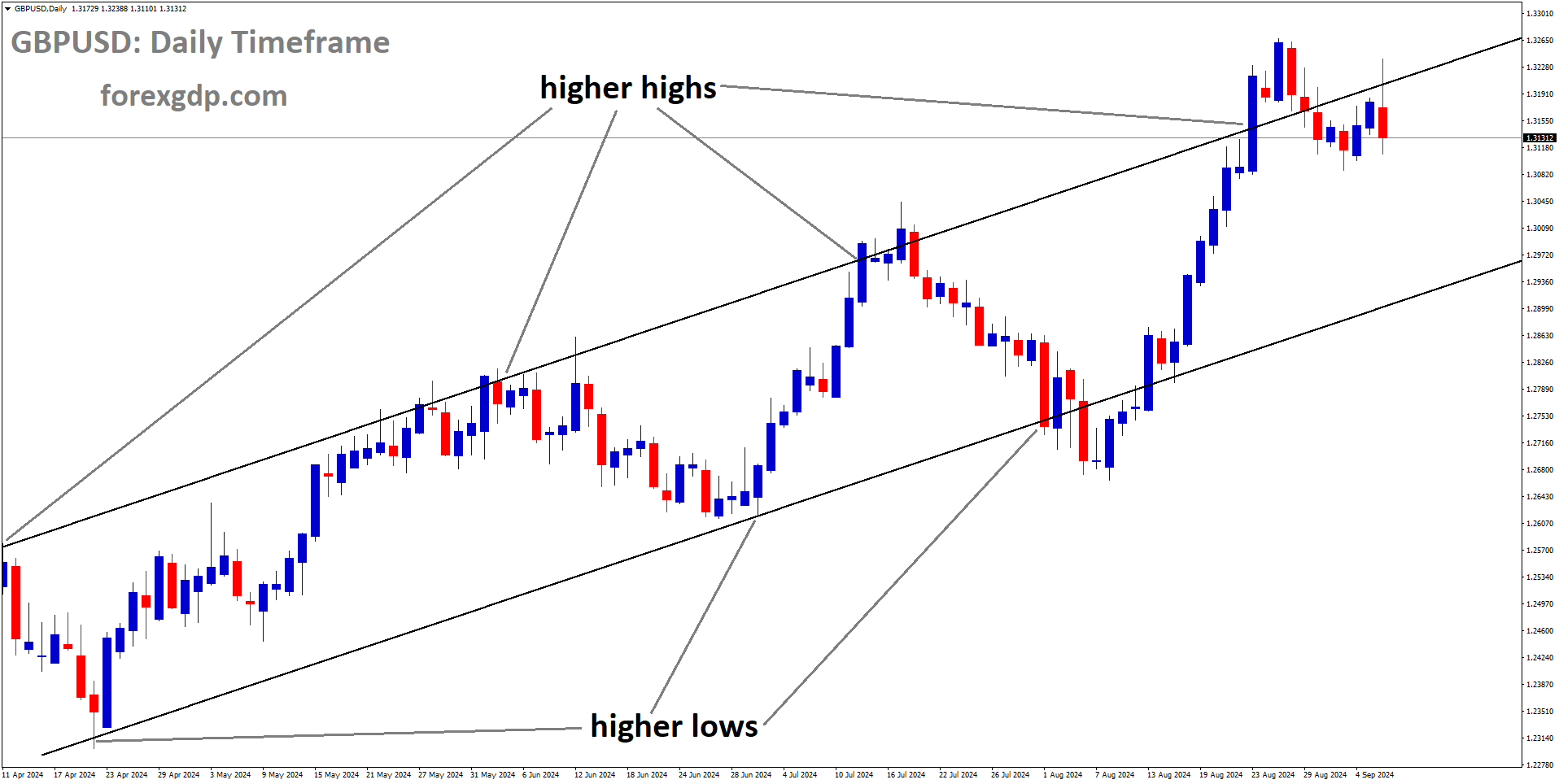
GBPUSD is moving in an Ascending channel, and the market has fallen from the higher high area of the channel
Pound Sterling’s Recent Struggles: A Temporary Setback?
The Pound’s recent dip against the US Dollar may be just a temporary setback. While the US Dollar has been bolstered by a mix of factors, including resilient economic data and anticipation of Fed rate cuts, the outlook for the Pound remains cautiously optimistic.
One thing to remember is that currency markets are incredibly fluid and can change quickly based on new data or shifts in market sentiment. While the Pound has faced some challenges recently, it’s not out of the game just yet. If the UK’s economic data remains solid and the BoE continues with its more cautious approach to rate cuts, the Pound could regain some of its lost ground.
Final Summary
The battle between the Pound Sterling and the US Dollar has been intense lately, with both currencies facing their own challenges. The US Dollar has remained strong despite a weaker-than-expected jobs report, thanks to a combination of resilient wage growth and market speculation that the Fed might start cutting interest rates soon.
On the other hand, the Pound Sterling has struggled to hold onto its gains, largely due to the lack of fresh economic data from the UK and a cautious approach from the Bank of England when it comes to cutting interest rates. However, the outlook for the Pound isn’t entirely bleak. Investors still expect the BoE to be more restrained in its rate-cutting cycle compared to other central banks, which could provide some support for the British currency in the near future.
As always in the world of forex, things can change quickly, so it’s worth keeping an eye on key economic data and central bank decisions in the coming weeks. Whether you’re rooting for the Pound or the Dollar, it’s clear that both currencies are in for an interesting ride!
USDCAD – USD/CAD Surges to 1.3500 Following Latest Employment Data from US and Canada
USD/CAD Rallies Near 1.3500 as US and Canadian Employment Reports Shake the Market
The USD/CAD currency pair has been on quite a ride lately, especially after the release of the employment data from both the United States and Canada. The numbers from these reports have sent waves through the market, leading to a strong rebound for USD/CAD, with the pair approaching the 1.3500 mark.
So, what exactly caused this shift in momentum, and what does it mean for both economies? Let’s take a deep dive into the factors behind this move, including the recent Nonfarm Payrolls (NFP) data from the US and the Canadian labor market updates.

US Nonfarm Payrolls: A Closer Look at the Weaker-Than-Expected Job Growth
The release of the US Nonfarm Payrolls (NFP) report for August turned out to be the key catalyst for the recent market movements. The job growth numbers for the month were weaker than anticipated, coming in at 142,000 jobs added, well below the expected 160,000. While this might sound alarming, it was still a step up from the prior month’s numbers, which were revised down to just 89,000 from 114,000.
But why does this matter so much? Well, the NFP report is one of the most closely watched indicators of economic health in the US. A lower number of jobs added suggests a potential cooling in the labor market, which in turn can influence decisions made by the Federal Reserve regarding interest rates. When job growth slows, it can signal that the economy is losing steam, leading to speculation about possible interest rate cuts to help stimulate economic activity.
In this case, the disappointing job growth figures have fueled expectations that the Fed might consider cutting interest rates sooner rather than later. This possibility had a direct impact on the US Dollar, which initially weakened following the report, only to recover swiftly as the day progressed.
Unemployment Rate and Wage Growth: Mixed Signals for the Fed
While the job growth numbers were lower than expected, there were some positive signals as well. The Unemployment Rate in the US dropped slightly, falling to 4.2% from the previous 4.3%. This was in line with market expectations, and while it’s a modest decline, it’s still a sign that the labor market isn’t in as bad shape as the job growth numbers might suggest.
On top of that, the Average Hourly Earnings data showed that wages grew at a faster-than-expected pace. Annual wage growth came in at 3.8%, up from 3.7%, and also higher than the previous month’s reading of 3.6%. This uptick in wage growth is important because it suggests that there may still be inflationary pressures in the economy. Higher wages can lead to increased consumer spending, which in turn can drive up prices, keeping inflation elevated.
However, despite the rising wages, the Federal Reserve’s main focus at the moment seems to be on ensuring that the labor market doesn’t weaken too much. If job growth continues to slow, the Fed could be more inclined to cut interest rates in an effort to prevent further economic slowdown.
Canadian Labor Market: Rising Unemployment Adds Pressure on the Loonie
Now, let’s turn our attention to Canada, where the employment data also played a significant role in driving the USD/CAD currency pair higher. In August, the Canadian labor market added 22.1K jobs, which on the surface seems like good news. However, it fell short of market expectations, which had forecast 25,000 new jobs.
But perhaps the more concerning figure for Canada was the Unemployment Rate, which rose to 6.6%, up from 6.4% in the previous month. This increase in the unemployment rate is a clear sign that the labor market in Canada is softening, and it adds to the growing concerns about the overall health of the Canadian economy.
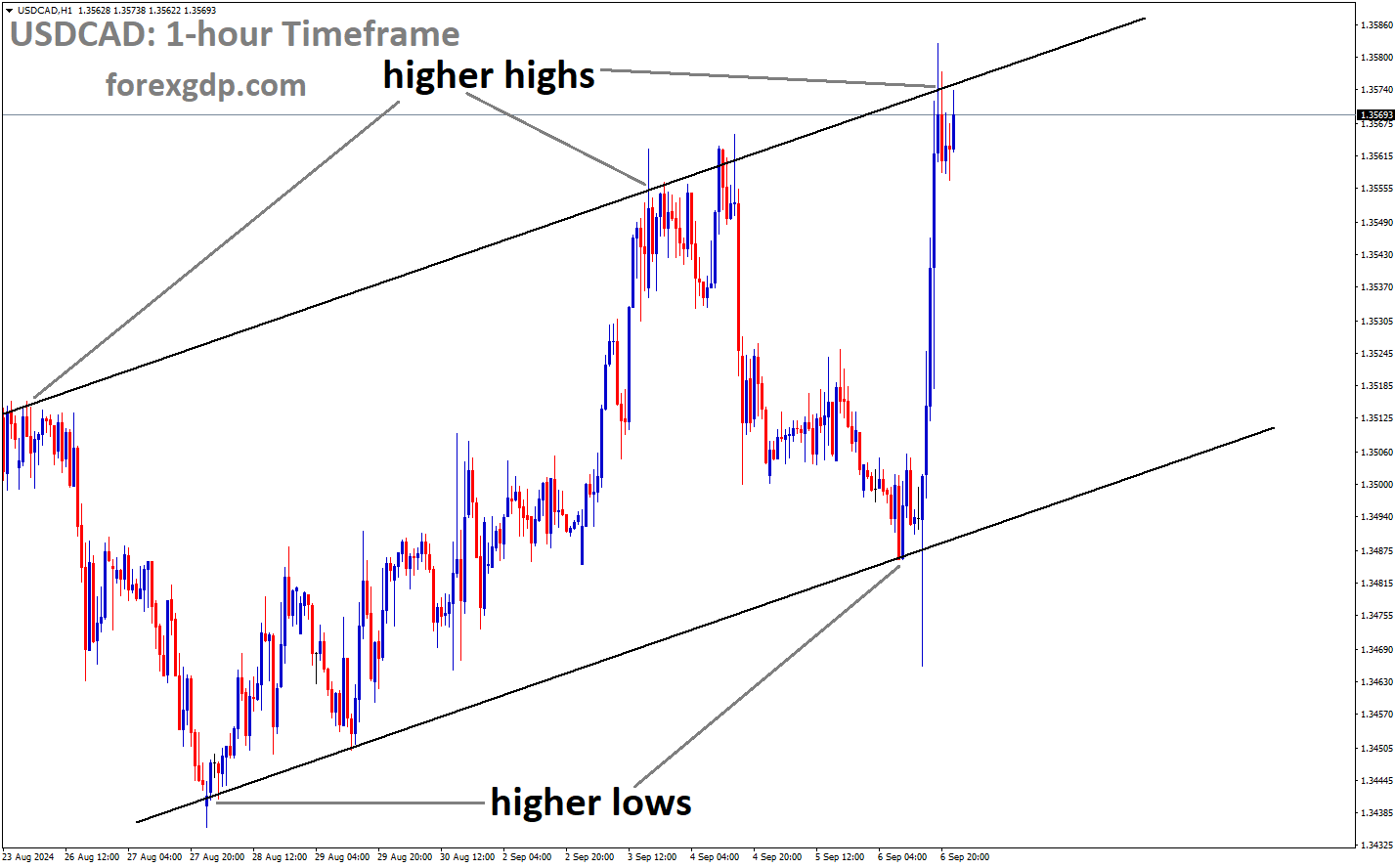
USDCAD is moving in an Ascending channel, and the market has reached the higher high area of the channel
July had already seen an unexpected loss of 1.4K jobs, so the latest data, while showing job gains, still points to a labor market that isn’t performing as well as many had hoped.
Easing Wage Growth: Another Factor Weighing on the Canadian Economy
In addition to the rising unemployment rate, Canada also saw a slowdown in wage growth. The Average Hourly Earnings figure decelerated to 4.9%, down from the previous reading of 5.2%. Slower wage growth means that consumers may have less disposable income, which could impact spending and, ultimately, economic growth.
The combination of rising unemployment and slower wage growth has led to increased speculation that the Bank of Canada (BoC) might have to step in with additional interest rate cuts to support the economy. Lower interest rates can help stimulate growth by making borrowing cheaper, but they also tend to weaken a country’s currency. This is part of the reason why the Canadian Dollar has come under pressure, allowing the US Dollar to regain strength in the USD/CAD pair.
The Impact of Employment Data on the USD/CAD Pair
The rebound of USD/CAD to near 1.3500 is a direct result of the mixed signals coming from both the US and Canadian economies. On the one hand, the weaker-than-expected job growth in the US has fueled speculation of interest rate cuts, which initially weakened the US Dollar. However, rising wages and a lower unemployment rate helped the greenback recover quickly.
On the other hand, Canada’s rising unemployment rate and slower wage growth have added pressure on the Canadian Dollar, making it harder for the Loonie to compete with the resurgent US Dollar.
What Does This Mean for the Future?
Looking ahead, the USD/CAD pair is likely to remain volatile as traders continue to digest the latest employment data and look for clues about future interest rate decisions from both the Federal Reserve and the Bank of Canada. Here are a few key factors to keep in mind:
- Federal Reserve’s Next Move: If job growth continues to slow in the US, the Fed may feel more pressure to cut interest rates to support the economy. However, if wage growth remains strong and inflationary pressures persist, the Fed may hold off on cutting rates.
- Bank of Canada’s Response: With the Canadian labor market showing signs of weakness, the Bank of Canada may need to cut interest rates to boost the economy. This would likely put more downward pressure on the Canadian Dollar, further supporting the USD/CAD pair.
- Global Economic Conditions: Broader global factors, such as trade tensions and geopolitical risks, could also impact the USD/CAD pair. If global growth slows, safe-haven currencies like the US Dollar may continue to strengthen, while risk-sensitive currencies like the Canadian Dollar could face further headwinds.
Final Summary: What Traders Should Watch for in USD/CAD
In the current environment, the USD/CAD pair is being driven by a mix of economic data and market expectations for future interest rate moves. The weaker-than-expected job growth in the US has increased speculation about potential interest rate cuts from the Federal Reserve, while rising unemployment and slower wage growth in Canada have put pressure on the Bank of Canada to take action as well.
For traders, this means that the USD/CAD pair is likely to remain volatile in the near term, as both US and Canadian policymakers weigh their options. Keeping an eye on future employment reports, wage growth figures, and central bank announcements will be key to understanding where the USD/CAD pair might head next.
USDCHF – Swiss Franc Gains as U.S. Job Market Weakens, USD Struggles

USD/CHF Struggles as Weak U.S. Labor Data Impacts the Market
In recent trading sessions, the USD/CHF currency pair has experienced notable movements, reflecting a mix of global economic shifts and investor sentiment. After hitting a recent low, the pair recovered slightly but has continued to hold onto its daily losses. What’s driving this volatility? The answer lies in the most recent U.S. labor market data, which has left investors wondering about the future of the U.S. economy and the Federal Reserve’s potential response.
In this article, we’ll dive deep into what’s going on with the USD/CHF pair, how weaker U.S. job data is influencing the market, and what it might mean for investors and traders.
The Impact of Weak U.S. Labor Market Data
The latest Non-Farm Payrolls (NFP) report for August has been a focal point for many in the financial world, as it provided fresh insight into the health of the U.S. economy. Unfortunately for the U.S. Dollar, the report didn’t bring the strong numbers many had hoped for. Instead, it revealed that the U.S. labor market is struggling to gain momentum, and this has had a ripple effect across global currency markets, including the USD/CHF pair.
What Is the Non-Farm Payrolls (NFP) Report?
If you’re unfamiliar, the Non-Farm Payrolls (NFP) report is a monthly data release that tracks the number of jobs added or lost in the U.S. economy, excluding certain sectors like agriculture. It’s a key indicator of the overall economic health of the country, making it a significant piece of data for traders and investors to keep an eye on.
In August, the NFP report showed that only 142,000 new jobs were created, falling short of the 160,000 jobs forecasted by analysts. This marked a continued trend of disappointing labor market data, as the revised number for July was also lower than initially expected at just 89,000 new jobs.
So, why does this matter? Well, a weaker job market means less economic growth, which can lead to slower consumer spending and overall economic activity. For the U.S. Dollar (USD), this has significant implications, as a weaker economy makes the currency less attractive to global investors.
How the Federal Reserve’s Decisions Are Shaping the Market
Alongside the weak labor market data, there’s another major factor influencing the USD/CHF pair: the Federal Reserve (Fed) and its upcoming decisions on interest rates. The Fed has been in the spotlight for some time now, with investors trying to predict what moves the central bank will make to address the current economic challenges.
Is a Rate Cut on the Horizon?
One of the most talked-about possibilities is whether the Fed will implement a rate cut at its next meeting. After the release of the disappointing August NFP report, many investors are betting that the Fed will lower interest rates to stimulate the economy. According to the CME FedWatch tool, there’s about a 40% chance of a larger 0.50% rate cut, although many expect a smaller 25 basis points (bps) cut to kick off what many believe will be an easing cycle.

USDCHF is moving in a descending channel, and the market has reached the lower low area of the channel
Lower interest rates typically reduce the appeal of the U.S. Dollar because they offer lower returns for investors. When the Fed cuts rates, it’s essentially saying that the economy needs a bit of a boost, which can cause the USD to weaken against other currencies, like the Swiss Franc (CHF).
In this context, the weak NFP report has made it more likely that the Fed will move toward cutting rates to help support the economy. This uncertainty has put pressure on the U.S. Dollar, as traders and investors are left to speculate on how deep the rate cuts might go and when they’ll happen.
The Swiss Franc: A Safe-Haven Currency
While the focus has largely been on the U.S. economy and the Dollar, it’s important to remember the other half of this currency pair: the Swiss Franc (CHF). The Swiss Franc is often seen as a “safe-haven” currency, which means it tends to strengthen when global markets are unstable or when there’s economic uncertainty.
Why Is the Swiss Franc a Safe Haven?
Switzerland is known for its economic and political stability, and its currency is highly regarded for maintaining its value in times of turmoil. When investors start to worry about the health of the global economy, they often turn to safe-haven assets like the Swiss Franc to protect their wealth.
In the case of the USD/CHF pair, this dynamic has been playing out as the U.S. Dollar weakens in response to poor labor market data and growing expectations of a Fed rate cut. Investors looking for a safer bet are shifting toward the Swiss Franc, which has put additional pressure on the USD/CHF pair, preventing the Dollar from recovering its losses.
What Could Happen Next?
So, with the U.S. labor market weakening and the Federal Reserve potentially gearing up for a rate cut, what can we expect to see in the coming weeks? While no one can predict the future with absolute certainty, there are a few key factors to keep an eye on.
1. More U.S. Economic Data
The August NFP report was just one piece of the puzzle. As the U.S. continues to release more economic data, especially on inflation, consumer spending, and industrial production, these reports will give a clearer picture of where the economy is headed. If upcoming reports also show weakness, it could put more pressure on the Fed to cut rates, further weighing on the U.S. Dollar.
2. Federal Reserve Policy Meeting
The Fed’s September 18 policy meeting is one of the most anticipated events in the financial world. At this meeting, the central bank is expected to provide more clarity on its plans for interest rates. If the Fed announces a significant rate cut or signals that more cuts are on the way, it could lead to further USD weakness and more gains for the Swiss Franc.
3. Global Market Sentiment
While much of the focus is on the U.S. and Switzerland, it’s important to remember that global market sentiment can also play a big role in driving the USD/CHF pair. Factors such as trade tensions, geopolitical risks, and overall economic uncertainty can influence investor behavior and the demand for safe-haven currencies like the Swiss Franc.
If global markets experience more volatility, we could see even stronger demand for the CHF, putting additional downward pressure on the USD/CHF pair. On the other hand, if global markets stabilize and risk appetite returns, the U.S. Dollar might regain some of its lost ground.
Final Thoughts on USD/CHF Movements
The USD/CHF pair has been under pressure due to weak U.S. labor market data and growing speculation about future rate cuts from the Federal Reserve. While the pair has managed to recover slightly from recent lows, the U.S. Dollar continues to face challenges as economic uncertainty looms large.
The Swiss Franc’s status as a safe-haven currency has only added to the USD’s difficulties, as investors look for more secure assets in times of market turbulence. With the Fed’s policy meeting coming up and more U.S. economic data on the horizon, the future of the USD/CHF pair is likely to remain unpredictable.
For traders and investors, staying informed about both U.S. and global economic developments will be key in navigating the ongoing fluctuations in the currency market. Keep an eye on major data releases, central bank decisions, and overall market sentiment to make the most informed decisions possible.
In this rapidly changing environment, being prepared and adaptable will help you stay ahead of the curve when it comes to trading the USD/CHF pair.
USD Index – Dollar Maintains Stability Following Uncertain NFP Results
US Dollar Strengthens After Mixed August Nonfarm Payrolls Data

When it comes to financial markets, every piece of news can send ripples across the globe. The US Dollar recently found itself in the spotlight after the release of the August Nonfarm Payrolls (NFP) data. While this report wasn’t all sunshine and rainbows, the US Dollar managed to recover, and investors started buzzing about potential changes in Federal Reserve policies.
If you’re curious about what happened, why the US Dollar bounced back, and what this means moving forward, you’re in the right place! Let’s dive into the details and break it all down in an easy, conversational way.
What is the Nonfarm Payrolls Report, and Why Does It Matter?
Before we go too deep, let’s first tackle what the Nonfarm Payrolls report is and why it matters so much. The NFP report is one of the most critical monthly indicators in the US. It provides insights into how many jobs were added (or lost) in the economy, excluding farm workers, government employees, private household staff, and non-profit organization employees. This report paints a clear picture of the employment situation in the country.
Why is this important? Well, employment is directly tied to economic growth. More jobs typically mean more spending, which boosts economic activity. If the NFP report shows strong job creation, that’s usually good news for the economy and the US Dollar. On the other hand, weak job growth can lead to worries about economic slowdown and can impact currency values negatively.
In August, the NFP data was somewhat mixed, and this caused markets to react in interesting ways.
A Mixed Bag: The August Nonfarm Payrolls Report
The August NFP report wasn’t exactly a home run. It showed that 142,000 jobs were added, which fell short of the forecast of 160,000. That’s a pretty significant miss, and it would normally spark concerns about economic weakness.
However, there were a few silver linings that helped the US Dollar recover some ground. For starters, the Unemployment Rate remained steady at 4.2%, which was in line with what most analysts expected. On top of that, Average Hourly Earnings, an indicator of wage growth, saw a year-over-year increase of 3.8%, beating expectations.
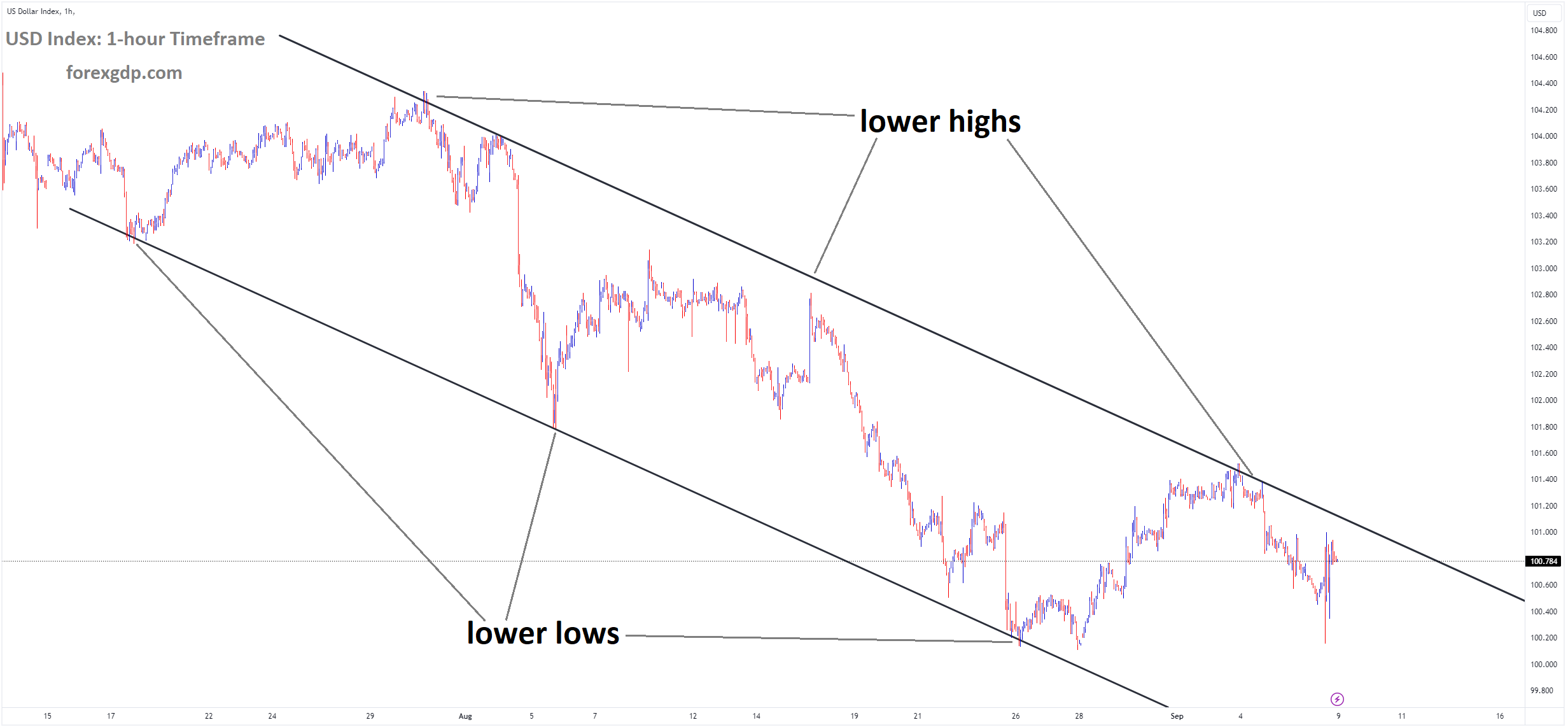
USD Index Market price is moving in the Descending channel
So, while the job creation number wasn’t stellar, the wage growth and stable unemployment rate painted a picture of a somewhat resilient labor market. These elements helped to soften the blow of the headline miss.
What This Means for the Federal Reserve’s Next Move
Now, here’s where things get really interesting. The Federal Reserve, often referred to as “the Fed,” is the institution responsible for managing monetary policy in the US. One of their main tools is the ability to adjust interest rates. When the economy is doing well, they might raise rates to keep inflation in check. But when the economy looks like it’s slowing down, they often lower rates to stimulate growth.
Given the mixed NFP report, investors immediately started speculating about what the Fed might do at its next meeting. The possibility of a rate cut in September has been on the table for a while, with many in the market expecting a 25 basis points (bps) cut.
But there’s more to the story.
Rumors of a Larger Rate Cut – Will It Happen?
After the release of the NFP data, there was chatter that the Fed might consider a more aggressive rate cut—perhaps 50 bps instead of 25. A rate cut of this size would send a strong signal that the Fed is worried about the economy and is willing to take bigger steps to support growth.
At one point, markets were assigning a 40% probability to the chance of a 50 bps cut, which is pretty substantial. However, it’s important to note that not all Fed officials seem to be on board with such a large move.
Chicago Fed President Austan Goolsbee’s Take
One notable voice in the conversation has been Chicago Fed President Austan Goolsbee. In the wake of the NFP report, Goolsbee made some comments that shed light on how the Fed might be thinking about interest rates. He suggested that while the Fed is beginning to align with the market’s view on the need for rate cuts, he downplayed the idea of a larger cut in September.
Essentially, Goolsbee indicated that the Fed might stick with a more conservative 25 bps cut, rather than the larger 50 bps cut that some market participants had hoped for. This is a classic case of balancing caution with action. The Fed doesn’t want to overreact to one piece of data, especially when there are still some positive indicators in the economy.
Why Did the US Dollar Recover?
Despite the mixed NFP report and the uncertainty about the Fed’s next move, the US Dollar managed to recover its footing. But why?
It all comes down to how markets interpret information. While the job creation number missed expectations, the stable unemployment rate and wage growth gave investors some confidence that the economy isn’t falling off a cliff just yet. Additionally, the fact that a 25 bps rate cut is almost a sure thing reassured markets that the Fed is ready to step in if needed.
In other words, the US Dollar’s recovery reflects a more nuanced view of the situation. Investors aren’t panicking; they’re waiting to see how things play out. And for now, the data suggests that while the economy might be slowing a bit, it’s not in free fall.
Looking Ahead: What Can We Expect?
So, where do we go from here? Well, the next few months are going to be critical in shaping the Fed’s approach to monetary policy. The central bank will likely continue to monitor data closely, paying special attention to employment, inflation, and overall economic growth.
While a 25 bps rate cut seems like a done deal, don’t rule out the possibility of further action if the economy starts to show more significant signs of slowing down. The Fed has made it clear that it’s willing to act to support the economy, but they’ll also be careful not to move too quickly or too aggressively.
For the US Dollar, this means we might see continued fluctuations based on how investors interpret incoming data and Fed signals. If the economy holds steady, the Dollar could remain relatively strong. However, if there are more signs of weakness, we might see some volatility ahead.
Summary: The US Dollar’s Resilience After Mixed Data
To sum it all up, the US Dollar’s recovery after the August Nonfarm Payrolls report is a reminder that financial markets are complex and influenced by multiple factors. While the job creation numbers were disappointing, stable unemployment and wage growth helped calm fears of an economic downturn.
The Federal Reserve remains the key player in this story, and its upcoming decisions on interest rates will likely continue to drive market movements. Whether the Fed goes for a 25 bps or 50 bps rate cut, its cautious approach will aim to balance economic risks with the need to avoid overreacting to short-term data.
For now, the US Dollar remains resilient, but as always in the world of finance, nothing is ever set in stone. Keep an eye on upcoming data and Fed statements for more clues about where things are headed next!
EURGBP – Euro Stumbles on Revised Growth Data, EUR/GBP Pulls Back
EUR/GBP Falls: Key Factors Behind the Decline and What it Means for Traders

The EUR/GBP exchange rate has been on a bit of a rollercoaster lately, and if you’re someone who likes to keep tabs on what’s happening in the financial markets, you probably noticed the sudden dip. But why did this happen? In this article, we’ll dive into the reasons behind the recent moves in the EUR/GBP, especially after the Eurozone GDP data was revised. We’ll explore how this revision impacts the market, why the British pound seems stronger, and what traders should expect in the near future.
Let’s get into the details of why EUR/GBP is on the move and what’s behind these fluctuations.
Eurozone GDP Revision: Why It Matters
The main trigger for the recent fall in EUR/GBP was the release of the Eurozone’s Gross Domestic Product (GDP) data for the second quarter (Q2). Initially, the growth rate was estimated to be 0.3%. However, the revision lowered this figure to 0.2%. While this may seem like a minor change, in the world of economics, even small adjustments can have significant effects.
What Does the GDP Revision Mean for the Euro?
At its core, GDP measures how much an economy is growing, and a lower-than-expected number signals that things aren’t going as well as previously thought. When the Eurozone’s growth was revised down, it sparked concerns among traders and investors.
The revision adds pressure on the European Central Bank (ECB) to rethink its monetary policy. A slower growth rate hints that the current interest rates may be too high, potentially stifling economic activity. In simple terms, higher interest rates can make borrowing more expensive, which can slow down spending and investment.
So, why is this important for the EUR/GBP exchange rate? If the ECB decides to lower interest rates, it reduces the appeal of the Euro. Investors often seek out currencies with higher interest rates because they offer better returns. A potential interest rate cut from the ECB would make the Euro less attractive to investors, leading to a decline in its value compared to other currencies, such as the British pound.
Sterling Strength: Why the British Pound Is Holding Strong
While the Euro has been under pressure, the British pound (GBP) has shown resilience. There are several reasons behind the pound’s recent strength. The primary reason is that investors believe the Bank of England (BoE) will be slower in cutting interest rates than the ECB.
Why Is the Bank of England Slower to Cut Rates?
The BoE’s slower approach to rate cuts is tied to the UK’s relatively stronger economic growth compared to the Eurozone. Recent data has shown that the UK economy is still growing, and inflation, particularly in the services sector, remains high. This is important because central banks typically raise interest rates to combat inflation, and they only start cutting rates when inflation is under control and growth slows.

EURGBP is moving in an Ascending channel, and the market has reached the higher high area of the channel
The BoE is expected to make a minor rate cut of 0.25% by the end of 2024, reflecting cautious optimism about the economy. In contrast, the ECB is expected to cut rates more aggressively, with many economists predicting a reduction of at least 0.50% before the year ends.
In short, while the Euro is being weighed down by the potential for more significant rate cuts, the pound is being buoyed by expectations that the BoE will take a more measured approach.
The Market’s Reaction: What Traders Need to Know
Traders have been quick to react to these developments. When the Eurozone GDP revision was announced, many sold off their Euros, leading to the decline in EUR/GBP. This sell-off brought the exchange rate back into a familiar range, hovering around the early 0.8420s.
But what does this mean for traders going forward?
1. Interest Rate Expectations Are Key
One of the most important factors driving currency prices is interest rate expectations. If traders believe that one central bank will cut rates faster than another, they will likely favor the currency with the higher expected return. In this case, traders are betting that the BoE will cut rates more slowly than the ECB, making the pound more attractive compared to the Euro.
2. Economic Data Will Continue to Drive the Market
The EUR/GBP pair will remain sensitive to new economic data, especially data that relates to growth and inflation. For example, if future reports show that the UK economy is slowing more than expected, traders might start to revise their expectations for BoE rate cuts, which could weaken the pound. Conversely, if the Eurozone shows signs of stronger growth or lower inflation, it could reduce the pressure on the ECB to cut rates, supporting the Euro.
A Closer Look at the Central Banks’ Dilemmas
Both the ECB and the BoE face difficult decisions in the coming months. Let’s break it down.
The ECB’s Challenge
For the European Central Bank, the challenge is to strike a balance between controlling inflation and supporting economic growth. If the ECB cuts rates too quickly, it might fuel inflation, but if it doesn’t cut rates, it risks stifling the economy even further. The recent GDP revision highlights just how precarious the situation is in the Eurozone.
The BoE’s Challenge
On the other hand, the Bank of England is walking a tightrope. UK inflation is still above target, particularly in the services sector, and this could keep the BoE from cutting rates too soon. However, if growth slows unexpectedly, the BoE might be forced to cut rates faster than currently expected, which could weigh on the pound.
What’s Next for EUR/GBP?
Looking ahead, the future of the EUR/GBP exchange rate will be shaped by a mix of economic data and central bank decisions. Traders will be keeping a close eye on any hints from the ECB and BoE about their future policy moves. In the short term, it seems likely that the pound will remain relatively strong as long as the BoE maintains its slow approach to rate cuts.
However, if the UK economy starts to show signs of weakening, or if the Eurozone manages to stabilize its growth, we could see a shift in the EUR/GBP dynamic. For now, though, the pressure is squarely on the Euro, and the British pound is benefiting from this divergence in central bank policies.
Final Summary
The recent fall in the EUR/GBP exchange rate can be largely attributed to the downward revision of Eurozone GDP and the resulting expectations for future interest rate cuts from the ECB. The British pound, meanwhile, has remained strong due to expectations that the Bank of England will cut rates at a slower pace. This divergence in central bank policies is likely to keep driving the EUR/GBP pair in the coming months, with traders keeping a close eye on both economic data and any signals from central bankers.

Whether you’re an experienced trader or just someone curious about how currencies move, it’s clear that interest rates and economic growth will remain key factors shaping the EUR/GBP exchange rate in the near future. Keep an eye on the data and central bank decisions—it’s going to be an interesting ride!
AUDUSD – Australian Currency Slips as RBA Holds Steady on Interest Rates
Why AUD/USD Struggles After US Jobs Report: Key Insights
When it comes to understanding why the AUD/USD pair often struggles, it’s essential to consider various factors that impact both the Australian and US economies. Recently, the AUD/USD exchange rate has faced challenges, particularly after the release of the latest US Nonfarm Payrolls (NFP) report, which painted a mixed picture of the US job market.
In this article, we’ll dive into the details of why the Australian Dollar has been declining against the US Dollar, how the recent job data from the US plays a role, and what to expect from the Reserve Bank of Australia (RBA). Let’s explore these topics and make sense of how the dynamic between these two currencies is shaping up.
How the US Nonfarm Payrolls Shook the Markets
US Job Growth Misses Expectations
The US Nonfarm Payrolls (NFP) report is one of the most closely watched economic indicators in the forex market, and the August release didn’t deliver the best news. The report showed that only 142,000 new jobs were added in the US economy, a figure that fell short of the 160,000 jobs that were widely expected. When job growth slows down, it signals potential weakness in the economy, which can affect the strength of the US Dollar.
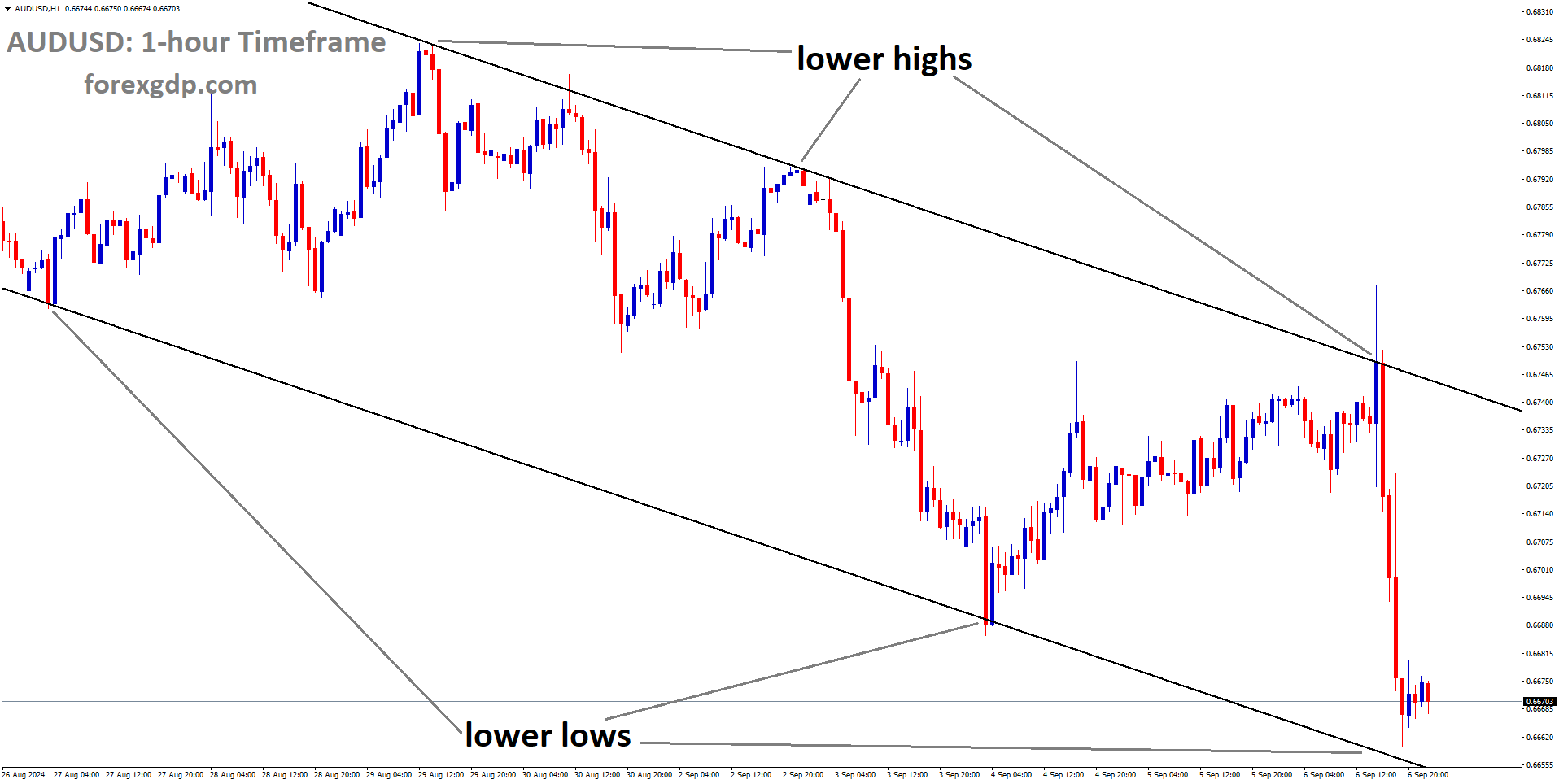
AUDUSD is moving in a descending channel, and the market has reached the lower low area of the channel
While the job numbers were lower than expected, the unemployment rate showed a slight improvement. It ticked down from 4.3% to 4.2%, suggesting that fewer people are looking for jobs. However, this decline in job creation left some investors concerned about the future health of the US economy.
Why Do NFP Reports Matter?
You might wonder why these job numbers are so significant. Well, employment data is a key indicator of economic health. When more jobs are created, it usually means people are spending more, businesses are growing, and the economy is expanding. On the other hand, slower job growth can signal economic trouble ahead, leading to weaker consumer spending and business activity.
For the Australian Dollar, the implications of a weak NFP report are multi-faceted. The market reaction can shift investors toward safer currencies, like the US Dollar, causing the AUD to fall as a result. This is precisely what happened after the latest report.
Why the Reserve Bank of Australia’s Stance Matters
RBA Holds Firm on Rates
On the other side of the equation, the Reserve Bank of Australia (RBA) has taken a more cautious yet hawkish stance. A hawkish stance essentially means the RBA is not in a rush to lower interest rates anytime soon. Despite the economic uncertainty and inflation concerns, the RBA is signaling that interest rates will likely remain stable, at least for the near future.
The central bank’s focus has been on controlling inflation, which has been running high in Australia. By keeping interest rates steady, the RBA is essentially trying to strike a balance between curbing inflation and supporting economic growth. This position suggests that, unlike the US Federal Reserve, which might consider lowering rates, Australia may not see rate cuts anytime soon.
Impact of RBA’s Stance on AUD/USD
This hawkish approach from the RBA can provide some support for the Australian Dollar, even in the face of broader challenges like the weaker NFP report in the US. However, because of the divergence in monetary policy between the US and Australia, the AUD still faces pressure. If the Federal Reserve decides to start cutting rates sooner than expected, it could create further uncertainty for the Australian Dollar.
What’s Driving the AUD/USD Decline?
So, why exactly is the Australian Dollar still falling against the US Dollar? It comes down to a mix of factors, including the diverging economic outlooks in both countries and the broader sentiment in the financial markets.
US Dollar Strength
One major reason is that the US Dollar remains relatively strong compared to the Australian Dollar. Even though the NFP report was underwhelming, the US Dollar continues to be viewed as a safe-haven currency. In times of uncertainty or when there’s any hint of economic weakness globally, investors tend to flock to the US Dollar, which is seen as more stable and reliable.

Economic Uncertainty in Australia
Meanwhile, the economic outlook in Australia is more uncertain. Inflation has been a major concern, and the RBA’s attempts to control it by keeping rates stable have left some investors cautious. Growth prospects are not as robust as they could be, and this adds pressure to the AUD.
Investors are also keeping an eye on Australia’s trade relations, particularly with China, its largest trading partner. Any disruptions or slowdowns in China’s economy can have a significant impact on Australia’s export-driven economy. This potential risk further adds to the AUD’s struggles against the USD.
What to Expect Moving Forward?
Market Sentiment and Investor Confidence
Looking ahead, one of the key drivers for the AUD/USD pair will be market sentiment. If the US continues to show signs of economic resilience, even with weaker job growth, the US Dollar could continue to outperform the Australian Dollar. On the flip side, if the RBA signals a more aggressive stance on inflation, or if Australia’s economic prospects improve, we might see a reversal in the AUD’s fortunes.
Potential for Policy Shifts
Another factor to watch closely is any shift in monetary policy from either central bank. If the Federal Reserve becomes more dovish and starts cutting rates, it could weaken the US Dollar, providing some relief for the AUD. However, as long as the RBA remains hawkish and inflation remains a concern, the downside for the AUD might be limited.
While these policy decisions are critical, other global events like trade dynamics and geopolitical tensions can also influence the AUD/USD exchange rate. Keeping an eye on these broader factors is essential for understanding where the currency pair is headed next.
Final Thoughts: Navigating the AUD/USD Market
The AUD/USD pair is currently navigating a challenging environment, marked by weaker-than-expected US job data and a hawkish RBA. While the Australian Dollar has struggled to gain ground against the US Dollar, the situation remains fluid. The mixed signals from the US labor market and the RBA’s focus on inflation control create a complex backdrop for both currencies.
For those closely following this pair, it’s essential to pay attention to upcoming economic reports, central bank decisions, and shifts in global market sentiment. Both the US and Australian economies have their unique challenges, and how they address these issues will shape the future direction of the AUD/USD exchange rate.
Whether you’re a trader or simply interested in the global financial landscape, understanding the factors influencing the AUD/USD is crucial for making informed decisions. While the path ahead may be uncertain, staying informed will help you navigate the twists and turns of the currency market with confidence.
NZDUSD – NZD/USD Strengthens to 0.6230 as US Dollar Stumbles Before Jobs Release
NZD/USD Gains Momentum as US Dollar Weakens Ahead of US Employment Data
The NZD/USD pair has recently seen a rise in value, approaching the 0.6230 mark, as the US Dollar (USD) weakens due to growing concerns over the United States job market. With the US Federal Reserve (Fed) holding a restrictive monetary policy, investors are turning their attention to upcoming employment data, which could shape future interest rate decisions. But what does all this mean for the Kiwi Dollar (NZD), and why is the US Dollar under pressure?

Let’s break it down, look at the factors influencing this movement, and explore why the NZD is gaining ground.
Why Is the US Dollar Losing Strength?
The US Dollar’s decline has been a significant driver behind the NZD/USD pair’s recent performance. But what exactly is causing the USD to lose value? There are a few factors to consider here.
Concerns Over the US Labor Market
A major reason for the weakening USD is the current state of the US labor market. Over the past few months, signs have been emerging that the labor market may not be as strong as previously thought. Job vacancies are decreasing, and private sector demand for labor has slowed down. This slowdown has created concerns about the health of the US economy, and many are questioning whether the Federal Reserve’s aggressive stance on interest rates is doing more harm than good.
When the labor market shows signs of weakness, it usually puts pressure on the central bank to reconsider its policies. In this case, there’s a growing belief that the Fed may soon start reducing interest rates to support the economy. Investors are increasingly betting that the Fed will cut rates in the coming months, which has led to a decrease in the value of the USD.
Monetary Policy Expectations in Focus
The US Federal Reserve has maintained high interest rates for an extended period, aiming to combat inflation. While inflation concerns remain, the cracks in the labor market are becoming more apparent. Investors are now wondering if the Fed’s approach is sustainable.
While the possibility of rate cuts is gaining traction, there is still uncertainty over the size of the cut. Some expect the Fed to lower rates by a modest amount, while others are speculating that a more significant cut could be on the horizon. The growing expectation that the Fed will reduce rates sooner rather than later is putting downward pressure on the USD.
The Role of the US Employment Data
A key factor that could shape the Fed’s next move is the upcoming US employment data, particularly the Nonfarm Payrolls (NFP) report. This report, set to be released soon, will provide a clearer picture of the current state of the US job market.
What is Nonfarm Payrolls (NFP)?
Nonfarm Payrolls is a key economic indicator that measures the number of new jobs added to the US economy, excluding certain sectors like agriculture. This report is closely watched by investors and policymakers because it gives an insight into the strength of the labor market.

NZDUSD is moving in an Ascending channel, and the market has reached the higher low area of the channel
For August, analysts are expecting the NFP report to show that US employers added 160,000 new jobs, which would be an improvement over the 114,000 added in July. The unemployment rate is also expected to decline slightly, from 4.3% to 4.2%.
If the NFP report shows strong job growth, it could ease some concerns about the labor market and reduce the likelihood of a large interest rate cut. However, if the data comes in weaker than expected, it could further solidify expectations of a rate cut, putting additional pressure on the US Dollar.
What’s Happening with the NZD?
While the USD is under pressure, the New Zealand Dollar (NZD) has been performing strongly. The Kiwi has gained momentum recently, thanks to some positive developments both at home and abroad.
Impact of China’s Economic Policies
One of the major factors driving the strength of the NZD is the economic policies coming out of China. As one of New Zealand’s largest trading partners, China’s economic health has a direct impact on the Kiwi Dollar. Recently, the People’s Bank of China (PBoC) has been implementing supportive monetary policies aimed at stimulating growth.

The PBoC has made it clear that they will continue to implement policies designed to support both businesses and households. By lowering financing costs and improving access to credit, the central bank hopes to boost economic growth. This, in turn, has a positive impact on New Zealand, as increased economic activity in China often leads to higher demand for New Zealand’s exports, particularly in the agriculture and dairy sectors.
What Does This Mean for the New Zealand Economy?
For New Zealand, the economic policies in China are a welcome development. The NZD has been gaining strength on expectations that the supportive measures from the PBoC will lead to increased foreign investments and stronger economic ties between the two countries.
New Zealand’s economy relies heavily on exports, and China is a major market for its goods. Therefore, any signs of growth in China tend to benefit the Kiwi Dollar. The combination of a weakening US Dollar and a stronger outlook for the New Zealand economy has helped push the NZD/USD pair higher.
Where Is the NZD/USD Headed Next?
So, with all this information in mind, where might the NZD/USD pair be headed in the coming weeks?
The answer largely depends on what happens with US interest rates and the state of the labor market. If the US employment data comes in weaker than expected and the Federal Reserve signals that it is ready to cut rates, we could see further declines in the USD, which would likely push the NZD/USD pair higher.
On the other hand, if the US labor market shows signs of strength and the Fed takes a more cautious approach to cutting rates, the USD could regain some of its lost ground, which might limit further gains for the NZD.
For now, all eyes are on the upcoming Nonfarm Payrolls report and how the Federal Reserve reacts to the evolving economic conditions. In the meantime, the NZD appears to be in a good position to benefit from both global economic trends and domestic factors like its strong trading relationship with China.
Final Thoughts
The NZD/USD pair has been gaining ground recently due to a combination of factors, including a weakening US Dollar and positive developments in New Zealand’s key trading partner, China. While the outlook for the NZD is currently positive, much will depend on the upcoming US employment data and the Federal Reserve’s next move.
For those keeping a close eye on the NZD/USD pair, it’s essential to stay informed about global economic trends and central bank policies. With so many moving parts, the currency market can be unpredictable, but understanding the factors at play can help you navigate the shifts more effectively. Whether you’re a seasoned trader or just starting, it’s always wise to keep an eye on the bigger picture when making decisions.
BTCUSD – Crypto Market Shaken: Bitcoin Drops Close to $54K Amid August Jobs Report
Bitcoin Drops Below $55K as August Jobs Report Shakes Crypto Market
When major economic news hits, it doesn’t just impact the stock market – the crypto world also feels the tremors. This was evident once again when the U.S. released the August Nonfarm Payroll (NFP) jobs data, which came in below expectations. As a result, Bitcoin’s price took a sharp dive, slipping below $55,000. The market responded with a wave of liquidations, totaling nearly $82 million in Bitcoin alone. Let’s break down what happened, why this matters, and what might come next for Bitcoin and the crypto market.

Understanding the NFP Report and Its Impact on Crypto
To start, let’s quickly explain what the Nonfarm Payroll (NFP) report is and why it’s such a big deal. The NFP report is a monthly update that shows how many jobs were added to the U.S. economy, excluding farm workers and a few other categories. It’s one of the most important economic indicators because it gives us insight into the health of the labor market. And, as we all know, the labor market plays a huge role in the broader economy.
Now, you might be thinking: what does a jobs report have to do with Bitcoin? The answer lies in how investors react to economic news. When the job market looks weak, it can cause concerns about the economy’s future. This, in turn, makes investors more cautious and less willing to put their money into risky assets like cryptocurrencies.
Historically, Bitcoin has shown sensitivity to major economic events, and the release of the NFP report is no exception. While Bitcoin is often seen as a hedge against traditional financial markets, it’s still influenced by economic uncertainty.
August NFP Report: What the Numbers Tell Us
The August NFP report wasn’t exactly what the market was hoping for. The report showed that the U.S. added 142,000 new jobs in August, which sounds decent at first glance. But when you dig deeper, you realize that this number fell short of the expected 160,000 jobs, marking an 11% miss. On top of that, the job numbers for June and July were revised downwards, signaling that the labor market isn’t as strong as it seemed just a few months ago.
This weaker-than-expected jobs report raised concerns about the U.S. economy’s momentum. If businesses are slowing down their hiring, it could mean trouble is on the horizon, not just for traditional markets but also for the world of cryptocurrency. As a result, Bitcoin’s price quickly reacted, dropping by 4.7% and sliding below the $55K mark for the first time in weeks.
Bitcoin’s Price Reaction and the Market Fallout
Whenever there’s bad news in the broader economy, the crypto market tends to react quickly – and not always in the way investors hope. Following the release of the August NFP report, Bitcoin experienced a sharp decline, with its price falling to its lowest level since early August. According to Coinglass, this drop triggered $82 million worth of liquidations.

BTCUSD is moving in a descending channel, and the market has reached the lower low area of the channel
For those unfamiliar, liquidations happen when traders who have borrowed money to make bets on Bitcoin’s price (known as leverage trading) are forced to close their positions because the market moves against them. This can create a domino effect, where the forced selling causes even more price drops.
But Bitcoin wasn’t the only cryptocurrency to take a hit. The entire crypto market saw a downturn following the NFP report. Across the board, the market was down 4.7% in the 24 hours following the report’s release. Even meme coins like Dogecoin (DOGE) and Pepe (PEPE), which often move independently of broader market trends, saw declines of 7% and 4%, respectively. It wasn’t just a bad day for Bitcoin – it was a bad day for the entire crypto world.
AI Tokens Also Feel the Pressure
In recent months, AI tokens have gained significant attention as investors look to capitalize on the growing excitement around artificial intelligence. However, even this promising sector of the crypto market wasn’t immune to the NFP report’s impact. The AI token market saw a 7% decline in the hours following the report.
This dip in AI tokens is a reminder that even sectors with strong long-term potential can face short-term challenges when market sentiment turns negative. It’s also a signal that the market is currently in a cautious mood, with investors pulling back from riskier bets.
Bearish Sentiment Remains Mild Despite the Drop
While the NFP report and subsequent Bitcoin drop have undoubtedly rattled the market, it’s worth noting that the overall bearish sentiment around Bitcoin isn’t too extreme. According to data from Kaito AI, mentions of a Bitcoin bear market are still relatively low. This suggests that while the price drop has caused some concern, many investors still believe that this is a temporary dip rather than the start of a prolonged downturn.
This is an important point to consider. In the past, we’ve seen Bitcoin experience dramatic price swings, only to bounce back even stronger. While the current downturn might feel alarming, it’s possible that this is just a short-term blip in Bitcoin’s longer-term upward trend.
What’s Next for Bitcoin and the Crypto Market?
Now that the NFP report has been released and Bitcoin has reacted, the big question is: what happens next?
The focus is now shifting to the Federal Reserve and its upcoming meeting later this month. The Fed’s decisions on interest rates and other economic policies can have a huge impact on the markets, including crypto. If the Fed decides to keep raising interest rates in response to the weaker jobs data, we could see further pressure on Bitcoin and other cryptocurrencies.
On the other hand, if the Fed takes a more cautious approach and signals that it’s willing to hold off on further rate hikes, we might see some relief in the markets, including Bitcoin.
Final Summary
The release of the August NFP report sent shockwaves through the cryptocurrency market, with Bitcoin’s price dipping below $55K and triggering nearly $82 million in liquidations. While the overall market experienced a significant downturn, it’s important to remember that bearish sentiment remains relatively mild. This suggests that many investors see the recent price dip as a temporary correction rather than the start of a long-term decline.
As we move forward, all eyes will be on the Federal Reserve and its upcoming decisions. Will the Fed continue to raise interest rates, or will it take a more cautious approach in response to the weaker jobs data? The answer to this question could determine the next big move for Bitcoin and the broader cryptocurrency market.
In the world of crypto, nothing is certain. But by staying informed and understanding the broader economic factors at play, you’ll be better equipped to navigate the ups and downs of this exciting, fast-paced market. So, keep an eye on the news, stay patient, and remember – in the world of Bitcoin, volatility is just part of the journey.
Don’t trade all the time, trade forex only at the confirmed trade setups
Get more confirmed trade signals at premium or supreme – Click here to get more signals , 2200%, 800% growth in Real Live USD trading account of our users – click here to see , or If you want to get FREE Trial signals, You can Join FREE Signals Now!


